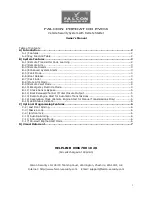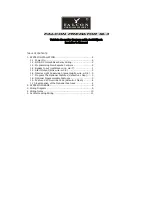
1. Information About Carbon Monoxide
Conditions That Can Produce Carbon Monoxide
The following conditions can result in transient CO situations:
• Excessive spillage or reverse venting of fuel-burning appliances caused
by outdoor ambient conditions, such as, wind direction and/or
velocity, including high gusts of wind, heavy air in the vent pipes
(cold/humid air with extended periods between cycles).
• Negative pressure resulting from the use of exhaust fans.
• Simultaneous operation of several fuel-burning appliances competing
for limited internal air.
• Vent pipe connections vibrating loose from clothes dryers, furnaces, or
water heaters.
• Obstructions in, or unconventional, vent pipe designs which can
amplify the above situations.
• Extended operation of unvented fuel-burning devices (range, oven,
fireplace, etc.).
• Temperature inversions which can trap exhaust gases near the ground.
• Vehicle idling in an open or closed garage, or near a home.
To be safe, know the possible sources of CO in your home. Keep fuel-
burning appliances and their chimneys and vents in good working
condition. Learn the early symptoms of exposure, and if you suspect CO
poisoning, move outside to fresh air and get emergency help. Your first
line of defense is an annual inspection and regular maintenance of your
appliances. Contact a licensed contractor or call your local utility
company for assistance.
Information About Carbon Monoxide Alarms –
What They Can and Cannot Do:
CO alarms provide early warning of the presence of CO, usually before a
healthy adult would experience symptoms. This early warning is possible,
however, only if your CO alarm is located, installed and maintained as
described in this guide.
Because carbon monoxide is a cumulative poison, long-term exposures to low
levels may cause symptoms, as well as short-term exposures to high levels.
This Carrier unit has a time-weighted alarm – the higher the level of CO
present, the sooner the alarm will be triggered.




























